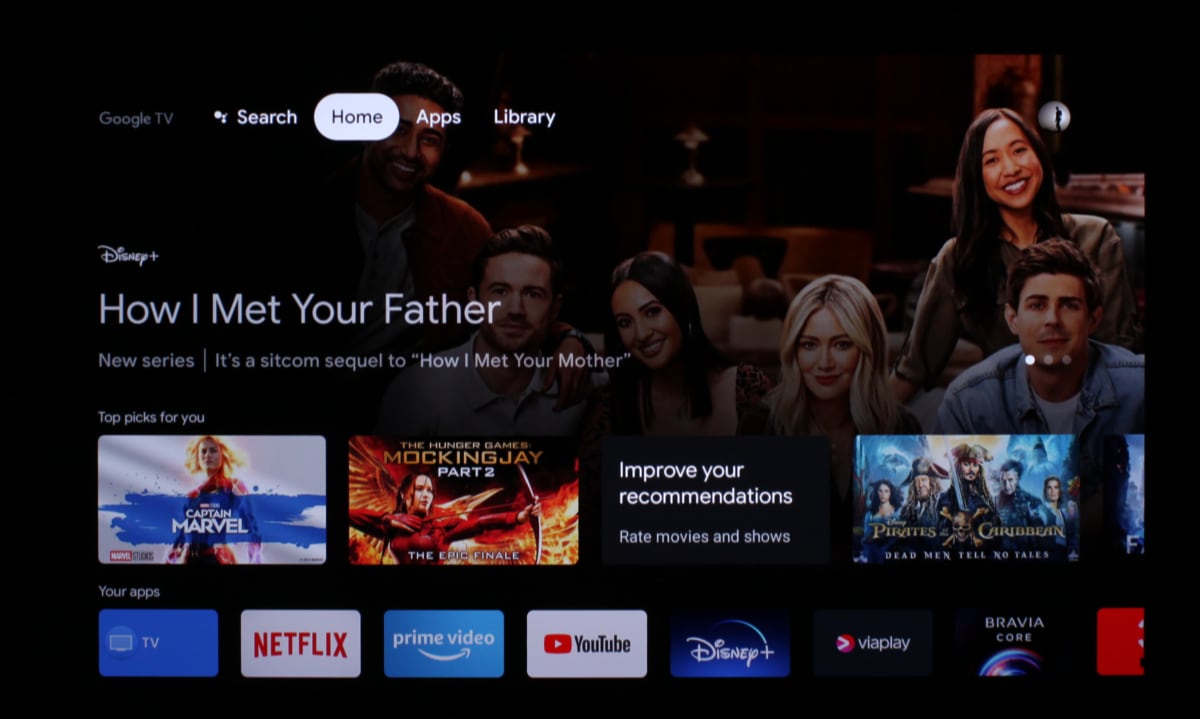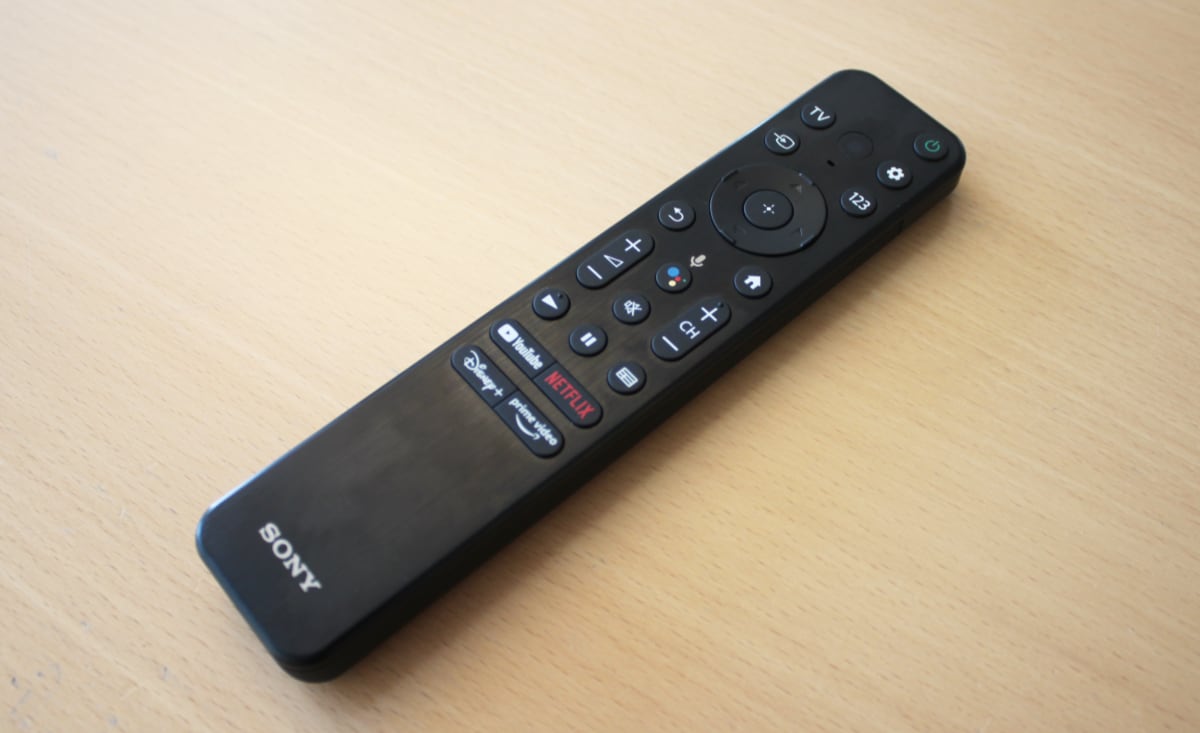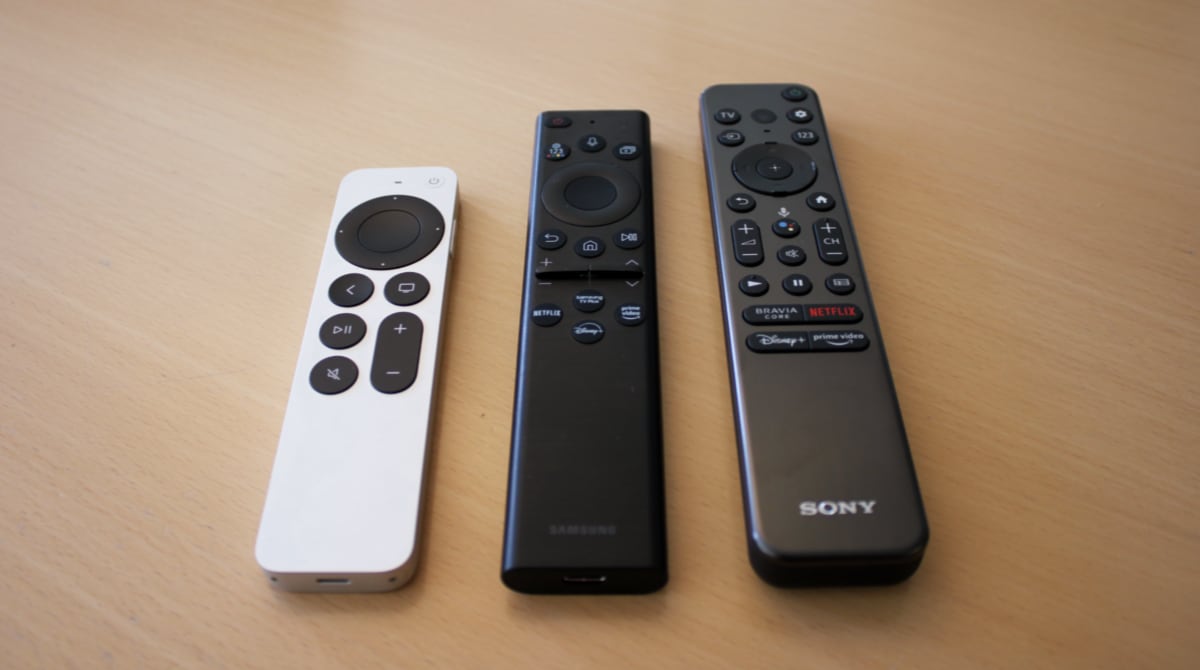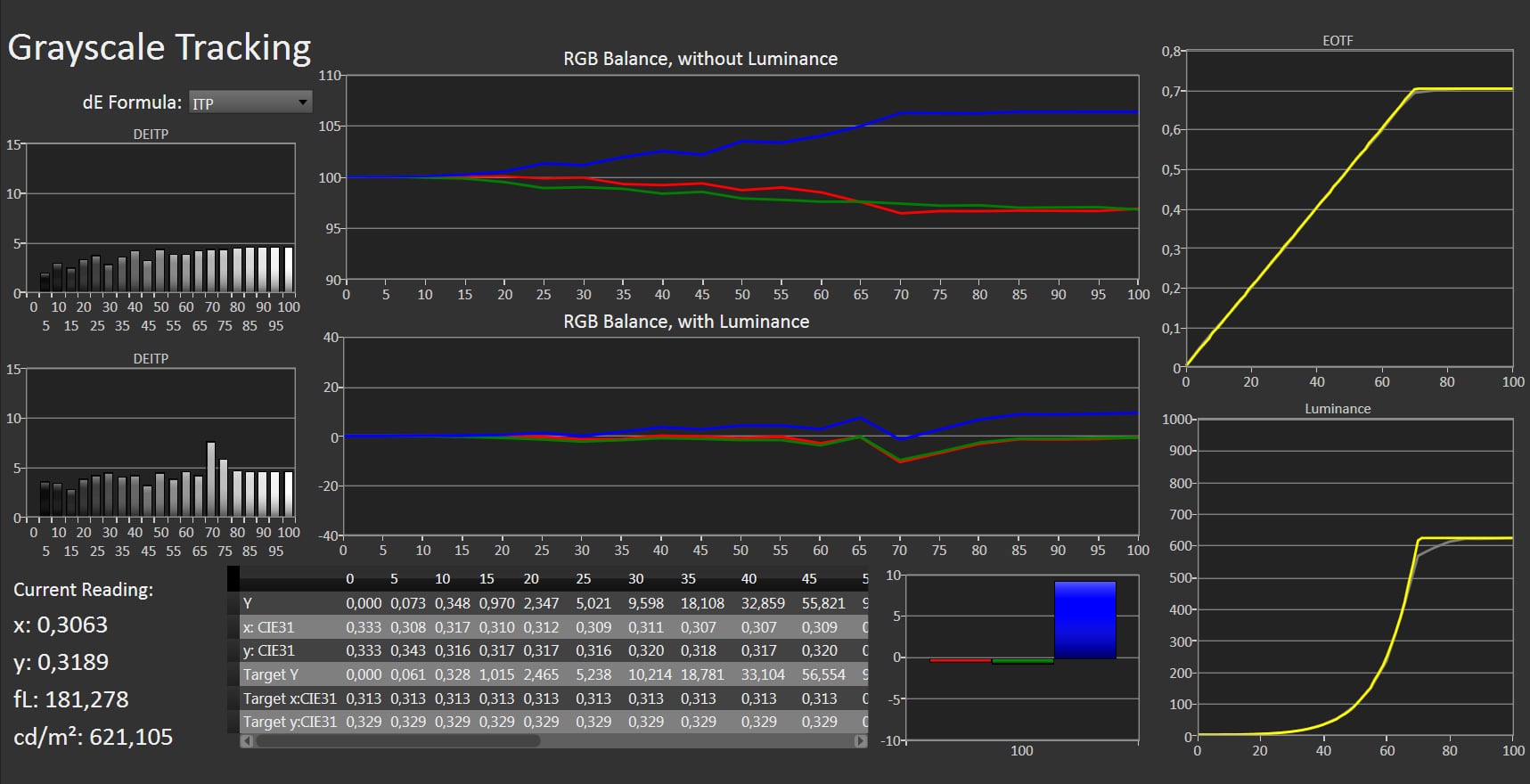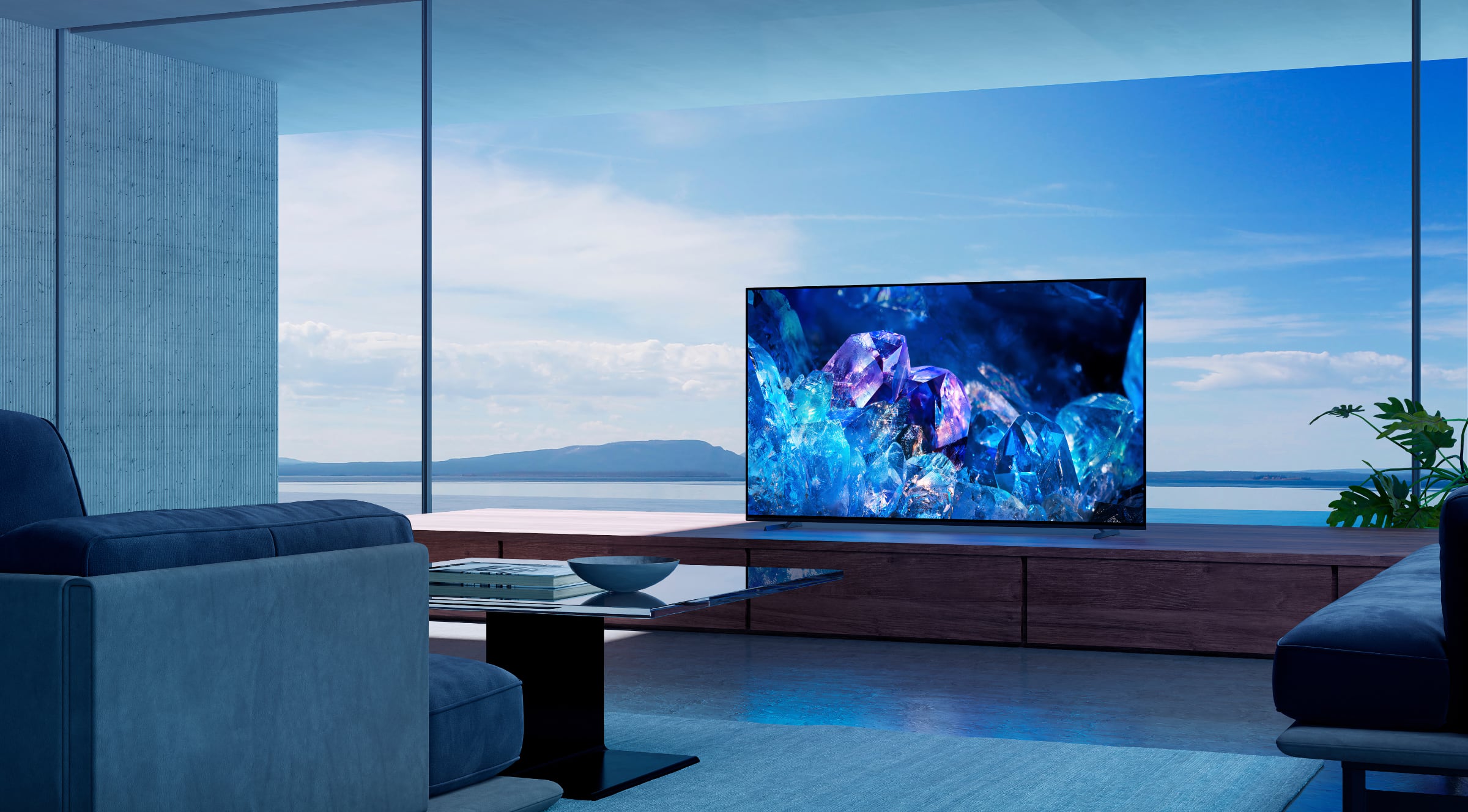Review: Sony A80K OLED
A80K is Sony's more affordable range of OLED TVs with 4K resolution, 120/100Hz support, and HDR capabilities but a less advanced OLED panel than the flagship TVs. Sony A80K is available in 55, 65 and 77 inches. It runs Google TV and also comes with Apple's TV features (AirPlay 2, HomeKit). We have tested the 55 inch version. Also read: Sony 2022 TV line-up
First impressions | Functionality | Calibration | Measurements | Picture quality | Conclusion | Debate Price and retailers:
First impressions
Sony A80K has two-legged minimalistic design with a relatively slim bezel. Around back the electronics box takes up most of the surface space on the 55-inch model that is thicker at the top to support the thin OLED panel. HDMI and all other ports face to the side so you can wall-mount the TV flush to the wall and still access the inputs. There are two ports with HDMI 2.1 bandwidth (48Gbps) for 4K120 and VRR while the other two have standard HDMI 2.0 bandwidth for up to 4K60. It is possible to raise the feet in order to make room for a soundbar underneath the TV including the Sonos Arc which just about fits under the 55-inch A80K although it looks a little weird (see photo). Overall, it is a sturdy design that makes A80K look modern but also a little anonymous. If it wasn't for the Sony logo on the front bezel it would be hard to identify A80K as a Sony TV as it looks more or less like most other OLED TVs today.User experience & features
Setting up the TV takes a little time but it is a straightforward process that first takes you through the Google TV setup process and later Sony's added steps. You can set up the TV as a Google TV or a 'basic TV' in case you prefer to use an external media player such as Apple TV 4K or Nvidia Shield. Once again in 2022, Sony is using the MediaTek MT5895 system chip in A80K. It first appeared in 2019's Sony X900H / XH90 that we benchmarked in 3DMark and GFXBench against a Philips Android TV, Nvidia Shield and Apple TV 4K. MediaTek MT5895 is a relatively slow chip that works as a video platform but not a platform for gaming and other more advanced use cases that Android TV / Google TV can enable. Still in 2022 our Smart TVs remain much slower than our smartphones. We will include fresh benchmark tests in future reviews of Android TVs and Google TVs once they get upgraded SoCs. The fact that Sony A80K uses the same SoC as last year's models also explains why it is running Android 10 rather than Android 11 or 12. Sony is providing OS updates but has not commented on the timeline for 11 and 12. In essence, A80K is identical in terms of Google TV functionality to last year's models so we refer to our Sony A90J review for an evaluation of the user interface and features as well as Sony's Bravia Core streaming service.Operation
Sony 2022 TVs come bundled with a new simpler and smaller remote control with fewer buttons, specifically 25 buttons as compared to 49 buttons on last year's remote. A80K has a black plastic version while the premium models (A90K OLED and up, X95K LCD and up) come bundled a premium version with a metal coating on top. Sony's remote control design has been in a limbo in recent years so we applaud the company for taking steps to improve usability. Combined with Google TV's simple navigation scheme the remote feels inviting and easy to get familiar with. It is a cleaner look but in our opinion there are still too many redundant buttons including the four sponsored buttons for Amazon Prime Video, Disney+, Netflix, and YouTube. The remote feels too light and cheap for a relatively expensive TV such as A80K. We have the A80K but the A83K and A84K variants include an added Find My remote feature that lets you use 'OK Google' to make the remote control play a sound so you can find it. It can also be activated with a button press on the TV. Here it is (the premium version) next to Samsung and Apple's latest remote controls.TV audio
A80K is fitted with Sony's 'Acoustic Surface Audio+' system that encompasses three speakers (3.2 channels) built directly into the OLED panel, or rather three actuators that use the OLED panel as a speaker membrane. Sony has used this system in various forms for years and it works well when paired to a bass speaker in the TV's chassis – A80K actually has two bass speakers. Also be aware that the 77 inch version has a more powerful center speaker (20W vs. 10W). The main advantage of Sony's Acoustic Surface is that voices sound as if they actually come from the persons on-screen which works very well in A80K with its dedicated center channel. You can maintain this effect even when using the TV with a separate Sony soundbar through a system that Sony calls 'Acoustic Center Sync' where the TV speakers act as a center channel. We did not get a chance to try it with A80K but recently tested it with A95K and Sony's HT-A9 speaker system. The speaker system in A80K is better than average but lacks something in midtones and obviously deep bass. It is a TV sound system that will most likely satisfy casual users but satisfy few when it comes to music. For watching movies and gaming we recommend a proper soundbar or separate speakers. A80K supports both Dolby and DTS audio formats via HDMI eARC passthrough (from a Blu-ray player etc.).Calibration
A80K has a total of 8 picture modes (Vivid, Standard, Cinema, Game, Graphics, Photo, IMAX Enhanced, Custom) in SDR of which several are redundant, if you ask us. And lots of picture modes for HDR10, too. Most recently, IMAX Enhanced made its way to Sony's TVs but it is not very accurate as shown below and in the table to the right in our measurements of A80K's various picture modes 'Cinema' used to be Sony's most accurate pre-calibrated mode but it has since been repurposed as a brighter picture mode with slightly oversaturated colors for allround daytime or evening viewing. You should now select 'Custom' if you want Sony's most accurate picture – or check our calibrated settings below. Sony's 'Game' mode is not perfect but it is one of the most accurate Game modes you will find on a TV which shows that Sony cares about how PlayStation games are presented. As for HDR, 'Custom' is once again the most accurate mode but it hits only a little over 620 nits peak brightness. Surprisingly, 'Vivid' hits almost 1100 nits peak brightness (with a significantly higher color temperature). We do not recommend using 'Vivid' as it produces wildly inaccurate colors and grey tones but if you simply want the highest peak brightness and don't care about the rest, it's there to use. With Dolby Vision content you should select Dolby Vision Dark for the most accurate picture. We measured DCI-P3 coverage to 98% and Rec.2020 coverage to 73% which is in line with other TVs based on LG Display's WOLED panel.Other picture modes
Click the title to expand the view
Cinema (SDR) Game (SDR) IMAX (SDR) Standard (SDR) Vivid (SDR) Cinema (HDR) Game (HDR) IMAX (HDR) Standard (HDR) Vivid (HDR) Measurements
In our "measurements" section we include all measurements and our suggested calibration settings. If you want to learn more about our test methodology click here. Note: Starting in 2021, we implemented a new method for measurement of average power consumption in SDR and HDR, meaning that earlier measurements are not 1:1 comparable. Power consumption in 'Calibrated' SDR mode is measured with the screen to approx. 100-110 nits to normalize the measurement across TV models (our recommended calibrated picture settings may differ). The new method will be used in all TV reviews going forward.Note: We include calibration settings only for SDR, not HDR. For our calibration we have deactivated the ambient light sensor that automatically adjusts the backlight setting according to your environment. You may prefer to have it enabled.Picture quality
A80K has not changed much from last year's A80J; it uses the same video processor and same MediaTek SoC which helps explain why it is still equipped with only two HDMI 2.1 ports. If you own more than one HDMI 2.1 game console, i.e. PlayStation 5 and Xbox Series X, this poses a limitation as one of the two HDMI 2.1 ports doubles as the eARC port. Hopefully Sony can address this shortcoming in 2023. If you are coming from an earlier OLED TV from Sony or another brand the most significant upgrade is HDMI 2.1 with 4K120 support because LG Display WOLED panel has not really changed much over the years. We have not identified important upgrades from Sony's X1 Ultimate video processor of the past to the newer Cognitive Processor XR in recent years models, unless you want to engage various picture enhancements. This is not to say that A80K is not a great TV, because it is. The OLED panel delivers inky blacks, extreme contrast, wonderful colors, and fast response without trailing or other motion artefacts. Combined with Sony's great picture processing A80K delivers exemplary SDR, meaning regular TV channels, Blu-ray, and HD streaming. Only thing missing is slightly higher fullscreen brightness for daytime viewing. In HDR there are no noteworthy improvements either. A80K delivers up to approximately 650 nits peak brightness in its accurate modes (6500 Kelvin) such as 'Custom' which is lower than what competing OLED TVs offer, and almost 1100 nits peak brightness in the more bluish, less accurate picture modes such as 'Vivid'. Like all other recent Sony TVs, A80K supports the HDR10, HLG and Dolby Vision formats but there is no support for HDR10+. Like other OLED TVs built on LG Display's WOLED panel, HDR peak brightness starts to drop as the area of the bright object gets larger. However, most other OLED TVs maintain peak brightness up to a 10% window (10% of the screen is white while the rest is black) whereas Sony A80K already starts to loose peak brightness capabilities on a 5% window which is a little disappointing. You can see how much in the measurement section. You will sometimes see this effect with real content, too. Full screen brightness reaches approximately 150 nits in 'Custom' and 185 nits in 'Vivid'. This is one area where OLED leaves room for improvement but it is up to LG Display – not Sony, LG Electronics or another TV brand – to address this limitation. The same goes for OLED panel dimming which still kicks in on some scenes where it should not such as a sports match with a static scoreboard or a game with a static HUD. It is not as bad as in the early OLED TVs generations but it still happens on WOLED whereas QD-OLED has delivered significant improvements in the area. Sony's flagship A95K QD-OLED TV delivers somewhat higher peak brightness (+260 nits) and last year's A90J (review), which carried over into 2022 as the step up from A80K, falls somewhere between the two. QD-OLED maintains color saturation better at higher luminance levels to ensure that bright colors in HDR look more vivid but on the other hand QD-OLED is not capable of delivering true black in bright environments or if there is a bright light source opposite the TV, and QD-OLED also has a triangular pixel layout that produces artefacts especially around text. We understand why Sony has positioned QD-OLED as its flagship but A80K with WOLED is still a great TV at a much lower price. It comes in up to 77 inches unlike QD-OLED which currently tops out at 65 inches. Overall, Sony A80K delivers wonderful SDR and HDR picture quality across movies, series and gaming. Due to OLED's self-emissive nature you actually get those 650 nits of peak brightness in stars, lamps and reflections because pixels are controlled individually which also ensures that colors are accurate and not affected by the type of scene or certain picture compositions that tend to confuse zone-dimming LCD TVs leading to inaccurate luminance and colors as well as artefacts. There is no blooming of any sort on OLED so HDR pictures look clear and stunning on A80K even if peak brightness and full screen brightness is lower than on some miniLED LCD TVs. Sony TVs do not have the Filmmaker Mode. Sony argues that its existing picture modes are as accurate, which is largely true, but it probably has more to do with the company's commercial partnerships considering that Sony – after Filmmaker Mode was introduced – added an IMAX Enhanced mode that is superfluous and not even accurate, as seen in the 'Measurement' section. Sony TVs do not support Dolby Vision IQ to adapt the Dolby Vision picture to match the viewing environment but A80K does have its own system in place for SDR and HDR10 room adaptation as well as Netflix Adaptive Calibrated Mode and Bravia Core Calibrated Mode. The latter two work only in the corresponding apps. In A80K, Sony's 'Ambient Optimization' adjusts screen brightness and tone curve but not white balance (reserved for A95K) to match the viewing environment. These systems can be deactivated, if you prefer. A80K's great picture quality extends to gaming, especially in HDR. Because of OLED's pixel-level brightness and color control, picture quality is generally not compromised in gaming despite the very low input lag in Game mode. This is in stark contrast to zone-dimming LCD TVs where dimming zones must be deactivated or toned down significantly to keep input lag to a minimum. For the best gaming experience with the best possible picture quality and lowest input lag / fastest response time you generally want the picture characteristics to be intrinsic to the individual pixel – and avoid support systems. The only area where picture quality is not fully maintained is VRR where raised blacks and flicker unfortunately continue to affect all TVs based on LG Display's WOLED panel including Sony A80K. It is not a dealbreaker but it is still there due to how the OLED panel is driven. We have explored 4K120 and other aspects of HDMI 2.1 between game consoles and HDMI 2.1-equipped TVs in much more detail in our Xbox Series X review and PlayStation 5 review. We measured input lag to 16.3 ms in 4K 60Hz which is not the lowest level but good enough for console gaming. Input lag is a little lower in 4K 120Hz but only a handful of console games render in 120fps at this point. Input lag is even lower in VRR which is now supported by both Xbox and PlayStation 5, and enabled in all Sony 2022 TV, no firmware update required. In other words; Sony A80K is a good companion for the latest generation of game consoles, even if it is missing an extra HDMI 2.1 port or two. In addition, A80K supports HGiG which can auto-calibrate HDR in PS5 games (there is no such thing as a manual HGiG mode in TVs). An extra advantage is that Sony's Game mode in both SDR and HDR is one of the most accurate you will find in a TV to ensure that games look as the game creators intended – unlike the horrific Game mode some other brands of TVs. If you are wondering BFI (Black Frame Insertion) is limited to 60Hz in all 2022 OLED TVs including A80K. Dolby Vision for gaming is not supported in Sony TVs. Other than that there is not much to add. As always with OLED, viewing angles are excellent but not perfect, Sony's MotionFlow system remains one of the best motion smoothing systems if you want to use it, and Sony's 'Smooth Gradation' can help smooth out banding seen in overly compressed content. Our sample had a uniform panel with a slightly brighter right side on very dark tones side but no color tinting issues. Overall WOLED panel homogeneity still leaves room for improvement.Conclusion
Ad:A80K is almost the same OLED TV as last year's A80J – same video processor, same MediaTek SoC, same Android version under Google TV, still only two HDMI 2.1 ports, same sizes in up to 77 inches – which was not a big upgrade from 2020's A8H, except for HDMI 2.1. It is a little disappointing that hardware development seems to have slowed to almost a standstill – we hope next year's model gets a hardware upgrade. Sony A80K competes with affordable OLED TVs from LG globally and Panasonic and Philips in Europe, and after the rush to get HDMI 2.1 features in 2019–2021 these TVs almost have feature parity. Of course there are still exclusive features in each brand's TVs which for Sony's part includes the Acoustic Surface speaker system, Google TV (until Philips gets it next year), and a couple of other things but A80K does not really set itself apart from the competition. A80K's limited HDR brightness is its main limitation compared to other OLED TVs. Nevertheless, Sony's 8 series remains an excellent TV in 2022 with impressive SDR and HDR picture quality for movie watching. It is also an excellent choice for console gaming on consoles such as PlayStation 5 and Xbox Series X that offer a handful of games with 120Hz output and many games in HDR. At the same time, it is in our opinion a significantly better TV than Sony's much more expensive and top-of-the-line 4K miniLED LCD TV, X95K, and a much cheaper option than Sony's flagship QD-OLED TV, A95K.Price and retailers:
Excellent HD. 4K & HDR
Contrast, black & viewing angles
Better-than-average TV speakers
HDMI 2.1 & eARC
Sony's motion systemHDR brightness
Google TV limitations in most regions
Lack of hardware upgrades
Only two HDMI 2.1 ports






